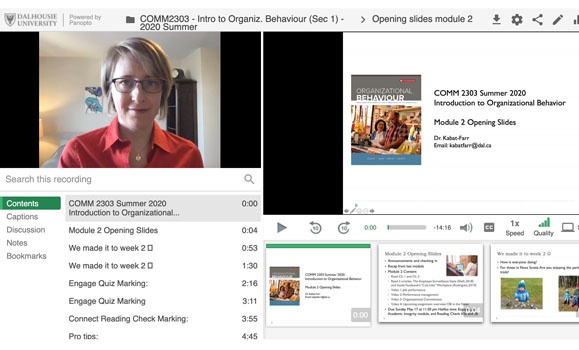When the Faculty of Management asked its second-year Commerce students this summer what courses the university should look to as exemplars of pilipili┬■╗Łful online learning, every single response mentioned Dana Kabat-Farr's Organizational Behaviour class.
You might expect Dr. Kabat-Farr's pilipili┬■╗Ł in engaging students online to stem from experience, but this was actually her first time ever teaching a course in an online format.
"I threw myself at the course, and I put a lot of work into reimagining it," she says of the second-year class, which ran this summer with 260 students enrolled.
 She organized topics differently, offered up a much wider variety of learning materials, completely overhauled her approach to student assessments, and embraced current events in shaping course content. By the time the term was to begin, about the only element of the course that remained the same was the textbook.
She organized topics differently, offered up a much wider variety of learning materials, completely overhauled her approach to student assessments, and embraced current events in shaping course content. By the time the term was to begin, about the only element of the course that remained the same was the textbook.
A required course for all Bachelor of Commerce students, Organizational Behaviour provides an overview of the theoretical basis of managing people in organizations and the practical application of that theory, tackling topics from personality and perception and group processes such as team development to contextual issues such as organizational culture.
Dr. Kabat-Farr's course was so well-regarded by students that Dal's Centre for Learning and Teaching (CLT) decided to open a portion of it up to other faculty as a demo last month, one of four courses made available for ŌĆ£tours.ŌĆØ ┬Ā
"These courses were intended to help faculty who had not taught online in the past ŌĆö or whose experience with online teaching was limited ŌĆö to see ŌĆśthe art of the possible,'ŌĆØ explains Brad Wutherick, CLT's executive director.
Build a framework first
Dr. Kabat-FarrŌĆÖs first move was to create a blueprint document for the course that gave her a birdŌĆÖs-eye view of all the material she wanted to cover. The template, available through CLT, allowed her to map out weekly learning objectives ahead of time without needing to get too into the weeds until later.
ŌĆ£Online teaching is a lot more upfront prep,ŌĆØ she says. ŌĆ£And, for me, I was teaching on the go because there just wasnŌĆÖt enough time. So, there was a lot of organization up front creating that framework, which then allowed me to plug stuff in throughout the term.ŌĆØ
The course blueprint revolved around a series of ŌĆ£modules,ŌĆØ each of which contained all the relevant pre-recorded lectures, files, assignments, quizzes and other learning materials on any given weekŌĆÖs particular topic.
Become a content curator
Next, Dr. Kabat-Farr turned her attention to how she could make the material as exciting and applicable to students as possible. She knew she wanted to include online videos, assessments, exercises and other multimedia in her mix of learning materials but wasnŌĆÖt really equipped to create those herself.
Instead, she began to think of herself almost as a curator of online content. Keen to avoid including shoddy materials in her course, she used her own expertise as a guide to discovering quality content.
ŌĆ£As a professor, youŌĆÖve got the background knowledge to sift through the poor-quality content,ŌĆØ she says. ŌĆ£YouŌĆÖre able to give the students the very best videos and articles that encapsulate a concept.ŌĆØ
 In most cases, she says, itŌĆÖs possible to find gems from reputable scholars and practitioners that fit well into the more traditional learning going on in a course through the textbook and lectures.
In most cases, she says, itŌĆÖs possible to find gems from reputable scholars and practitioners that fit well into the more traditional learning going on in a course through the textbook and lectures.
"I really appreciated her teaching style," says Kalleigh Maxwell (above left), a Commerce student from Halifax majoring in finance. "She also used a lot of YouTube videos and additional readings and things like that, so you didn't have to just rely on the textbook and take her word for it. You really had other interesting materials to pull from."
Make it relevant
To further increase student engagement, Dr. Kabat-Farr says she also built on current events to illustrate course concepts in a way that she hadnŌĆÖt in the past. She incorporated materials about the Black Lives Matter movement and drew in materials on social justice and diversity in the workplace, which is her own area of research interest.
ŌĆ£It really resonated with students and made it feel like this wasnŌĆÖt a course pulled out of a book. I was creating it on the go with them, and I think they liked that,ŌĆØ she says.
She says it also felt more natural to address some tougher issues online because she was able to package the material more carefully and in a way that promoted understanding rather than a quick rush to opinion.
For one assignment, students were asked to watch a TED talk about how to bring up racism up in the boardroom and to then write a reflective short answer about being ŌĆ£colour brave.ŌĆØ She says the responses were great.
Keeping it simple and predictable
Although instructors might be tempted to try out novel tech platforms, Dr. Kabat-Farr says students seemed to appreciate that she kept the learning tools simple. She used DalŌĆÖs official learning platform Brightspace, an online software tool, to organize all the modules and quizzes in her course.
ŌĆ£There was no work to do the work. It was always predictable,ŌĆØ she says.
She also applied the same principles to timelines and due dates. Students received all their content on Mondays and assignments were always due on Sundays. There was nothing that would appear mid-week. There was nothing that would come by surprise.
More resources: Online learning at Dal
Shifting approaches to student evaluation
In a typical year, Dr. Kabat-Farr would usually assign a team-based writing assignment and hold a final exam. This year, she completely did away with both of those components of the course.
 With the former, she knew that asking hundreds of students spread out around the world to collaborate on team assignments would be probably produce more headaches than highlights. As for the latter, she knew that any final exam would ultimately be open book, so she opted instead for mandatory weekly reading checks and quizzes that clearly mirrored the content covered that week ŌĆö all run through Brightspace.
With the former, she knew that asking hundreds of students spread out around the world to collaborate on team assignments would be probably produce more headaches than highlights. As for the latter, she knew that any final exam would ultimately be open book, so she opted instead for mandatory weekly reading checks and quizzes that clearly mirrored the content covered that week ŌĆö all run through Brightspace.
ŌĆ£I was worried about group work, assignments and finals and that sort of thing, but the way that Dr. Kabat-Farr organized her class was really one of my favourite outlines or ways of setting up a class,ŌĆØ says Kalleigh.
Dr. Kabat-Farr also experimented with new types of assignments and worked to make sure all of her materials were accessible (with closed captioning on lecture videos and the like).
Staying true to a teaching style
While the course changed a lot, Dr. Kabat-Farr still maintained her underlying teaching style, which is to empower students to take what they learn in her courses and apply it to their own organizational lives.
For the final assignment, she had students write a letter to their future selves addressing the question: If you could remember two things from the course, what would they be?
ŌĆ£I want students to somehow change their perspective on something, whether itŌĆÖs how to work effectively in groups, to challenge their implicit biases about different groups of people, to change how they view leadership. ItŌĆÖs a chance to broaden studentsŌĆÖ perspectives on issues.ŌĆØ

